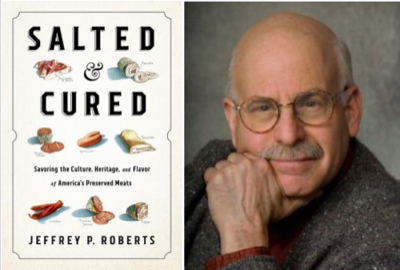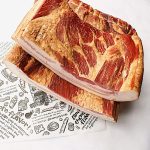An interview with Jeff Roberts: Writer, researcher and “professor” of fine fermented foods
 Jeff Roberts and I have run into each other at about a hundred conferences over the years! We’ve shared thoughts, heard each other present, eaten a meal or two together. Over the last thirty-five years, I think it’s safe to say that we’ve travelled moderately parallel paths through the culinary world! Each, of course, in his own way, but each focusing on learning about traditional food and cooking, and then sharing that learning through writing. Jeff’s book about cheese—The Atlas of American Artisan Cheese (Chelsea Green, 2007)—certainly focused on a lot of the same cheesemakers we’ve long worked with here.
Jeff Roberts and I have run into each other at about a hundred conferences over the years! We’ve shared thoughts, heard each other present, eaten a meal or two together. Over the last thirty-five years, I think it’s safe to say that we’ve travelled moderately parallel paths through the culinary world! Each, of course, in his own way, but each focusing on learning about traditional food and cooking, and then sharing that learning through writing. Jeff’s book about cheese—The Atlas of American Artisan Cheese (Chelsea Green, 2007)—certainly focused on a lot of the same cheesemakers we’ve long worked with here.
Last year his new book, Salted and Cured: Savoring the Culture, Heritage and Flavor of America’s Preserved Meats, came out—which made the man a natural for Camp Bacon. Here’s what his publisher, Chelsea Green, said about the book:
From country ham to coppa, bacon to bresaola.
Prosciutto. Andouille. Country ham. The extraordinary rise in popularity of cured meats in recent years often overlooks the fact that the ancient practice of meat preservation through the use of salt, time, and smoke began as a survival technique. All over the world, various cultures developed ways to extend the viability of the hunt—and later the harvest—according to their unique climates and environments, resulting in the astonishing diversity of preserved meats that we celebrate and enjoy today everywhere from corner delis to white-tablecloth restaurants.
In Salted and Cured, author Jeffrey P. Roberts traces the origins of today’s American charcuterie, salumi, and other delights, and connects them to a current renaissance that begins to rival those of artisan cheese and craft beer. In doing so, Roberts highlights the incredible stories of immigrant butchers, breeders, chefs, entrepreneurs, and other craftspeople who withstood the modern era’s push for bland, industrial food to produce not only delicious but culturally significant cured meats.
By rejecting the industry-led push for “the other white meat” and reinvigorating the breeding and production of heritage hog breeds while finding novel ways to utilize the entire animal—snout to tail—today’s charcutiers and salumieri not only produce everything from country ham to violino di capra but create more sustainable businesses for farmers and chefs.
Weaving together agriculture, animal welfare and health, food safety and science, economics, history, a deep sense of place, and amazing preserved foods, Salted and Cured is a literary feast, a celebration of both innovation and time-honored knowledge, and an expertly guided tour of America’s culinary treasures, both old and new.
A resident of Montpelier, Vermont, Jeff Roberts is president of Cow Creek Creative Ventures, which is dedicated to developing solutions in the areas of agriculture and food policy, conservation, the environment, and community economic development. He was cofounder and principal consultant at the Vermont Institute for Artisan Cheese at the University of Vermont. His book The Atlas of American Artisan Cheese (Chelsea Green, 2007) was the first comprehensive survey of small-scale producers. He is a member of Guilde Internationale des Fromagers. He teaches the history and culture of food at the New England Culinary Institute, is a visiting professor at the University of Gastronomic Science, provides consulting services to a wide array of small-scale food producers, and is a frequent speaker in Europe and the United States on artisan food, sustainable agriculture, and the working landscape. His new book, Salted and Cured, examines the history and culture aspects of dry-cured meat from 1630 to the present.
Here’s a bit of an interview so you can hear more from Jeff directly. And, of course, I hope you’ll come to Camp Bacon for the Main Event to hear him talk on Friday, May 31.
Ari: You have a pretty interesting background—from meteorologist to cured meat. Can you give us some background?
Jeff: Yeah, I got struck by lightning on the way to the slaughterhouse!
A lot of this goes back to family for me. I grew up with an interest in good food. My mother’s side of the family is from Italy. So there was always this interest for me with people who had very little money and yet they managed to create really delicious food. It’s a fascinating history. They were from Molise, in central Italy. So I was always interested in good eating.
When I was in the Navy and I got off the ship, my colleagues wanted to go get drunk, but I was hunting restaurants. When I was in graduate school in Philadelphia, it was similar. I was always seeking out things to eat that I didn’t know about and I was curious. When I left graduate school it carried over into my work. I went to work for U Penn—my first job was in fundraising for Morris Arboretum. My boss there used plants as a teaching tool to get folks excited and that made a really lasting impression on me.
Ari: What came after that?
Jeff: I got involved with School of Veterinary Medicine at Penn and became an associate dean. I had always thought about veterinary medicine as cats and dogs but over the years, of course, I realized it was also about farm animals. This was at a time in the late 80s when PETA was very active in pushing various kinds of growers who were doing some really abusive things to stop. I remember reading some stuff about why appropriate practices meant you not only treated an animal humanely but the quality of an animal’s meat, or eggs, etc. were the best. That when you treated an animal better, the quality of the food produced improved dramatically. At that time, some of my colleagues worked with industrial agriculture, doing some of the first BST (bovine growth hormone) research to increase milk yields. It was always interesting to hear how different what they did professionally was from what they themselves wanted to eat!
I went all over the country and had a chance to meet people who did great work with animals, including a visit to the MSU vet college in Lansing. I think knew people at every vet school in the country, many of whom made lasting impressions.
When I left Penn 25 years ago, I went to work for the Vermont Land Trust. And I started to use food as a teaching tool. I met people who were doing amazing things with food! I was one of the founders of the Vermont Fresh Network, and Shelburne Farms hired me to do adult education food programs. After leaving the Land Trust, I heard about Slow Food. So I sent a note to Slow Food, and Patrick Martins (one of the founders of Slow Food America and the man behind Heritage Foods) responded. And in 1999, when Carlo Petrini came to the U.S., Vermont was the first place they went! I was asked to co-chair the 2001 U.S. presence at Slow Cheese. I wanted to do some writing after I left the Land Trust. I realized that the stories of the cheesemakers were fascinating and I wanted to tell their stories! And that’s what started me on the work to do the Cheese Atlas. In 2006 I began teaching at the New England Culinary Institute. And this lead to Carlo Petrini inviting me to teach at Slow Food University of Gastronomic Science.
None of it’s ever really been planned. I guess I can smell an opportunity (or bacon!) and I just follow my nose! I never believed I’d end up in Vermont or that I was going to do all this in Italy.
Ari: What sort of history did you study?
Jeff: In grad school at Temple University I studied urban history and geography. But when I was in grad school, historians were a dime a dozen. Since a lot of my dissertation research was on the history of Philadelphia’s downtown, I went to work for a museum devoted to the city’s history. A lot of what I had learned in the Navy helped me to map Philadelphia’s downtown. I began volunteering with Museum Council of Philadelphia, where I met the director of the Morris Arboretum and was hired later as its first director of development. That got me to China for the first time.
Ari: What about the new book? It seems perfect for Camp Bacon!
Jeff: It’s all about the culture and history of cured pork in the U.S. What I discovered doing this book was all about the cultural landscape around food preservation . . . Like when Mark Kurlansky wrote about Cod.
Ari: That’s one of my favorite food books of all time!
Jeff: I realized as I started working on what became Salted and Cured that it was really all about the culture. You can’t understand the history of the United States without understanding the history of pork. It was what people lived on and that’s what I want to talk about. That what I really wanted to do was not to write just about ‘who was doing what,’ but how to focus more on what they represent in this shift in culture.
Among the most interesting surprises were people like Sant’Antonio Abate (St. Anthony the Abbott), an Egyptian Roman Catholic monk, who is the patron saint of butchers, domestic animals, basket-makers, and gravediggers. Sant’Antonio founded Christian monasticism and as such often treated people suffering from shingles, known as St. Anthony’s Fire (Fuoco di Sant’Antonio), with salves made from pork fat! People, impressed by portraits of Sant’Antonio, associated him with swineherds and butchers!
Or tracing Nancy Newsom Mahaffey’s six-hundred-year family history of smoking and curing hams! From ancestors in Lancashire who landed in early colonial Virginia to the Revolutionary War and then today’s Kentucky, family techniques and later recipes influence Nancy’s extraordinary handcrafted country hams. In 2009, a seventeen pound Newsom ham was enshrined at the Museo del Jamón, in Aracena Spain, crowned as one of the world’s greatest hams!
And how diverse, often liberal arts, backgrounds of many contemporary cured meats practitioners influence and shape their craft. Just how do experiences in fashion, reporting and writing, foreign service, French literature, classical music, graphic design, philosophy, furniture making, and agribusiness among others help create extraordinary foods?
Ari: Who are some of your favorite bacon makers and salami curers?
Jeff: There are dozens of them in the book! But one of them is Tony Fiasche, from Tempesta Foods. I’m excited to eat his food at the Bacon Ball and hear him speak at the Main Event of Camp Bacon! In my opinion, his n’duja is the best in the country!
Ari: Can you give us a bit of a preview into what you’ll be presenting at Camp Bacon?
Jeff: I want the audience to appreciate that you can’t understand the history of the United States without grasping the essential role of pork. I plan to share some historical context and my enthusiasm for discoveries about the culture around pork. Everything from language, religion, food taboos, diet, all reflect what pork represents culturally. For African-Americans, significant aspects of culture and community exist because of slave diets.
And there’s more to hogs and pork than just how to prepare it. And going back even further, the whole Middle East used to eat it. Pigs grow fast, they have plenty of litters, so if you domesticate the animal you have a reliable food source. I’ve been doing a lot of research, writing, and speaking about the renaissance of fermented foods: craft beer, artisan cheese, cured meat, pickling, and various beverages… a remarkable resurgence.
Ari: How are you feeling about coming to Ann Arbor for Camp Bacon?
Jeff: I’m looking forward to it, since haven’t I’ve been to Ann Arbor. I can’t wait to meet Mei Zheng and hear her talk at Camp Bacon because Yunnan is one of the first places visited when I went to China in 1986. The Chinese clearly were doing food preservation early, early on. Confucius, you often paid him for your lessons with preserved pork. I remember seeing lawei, similar to jerky, hanging from the rafters curing in Yunnan. And that’s what Mei Zheng writes about in her book, Travels in Dali; with a Leg of Ham. And I’m really excited to finally meet Tony Fiasche (from Tempesta). I definitely want to go the dinner he’s cooking at the Roadhouse on Thursday (May 30).
Ari: Before I let you go, what’s your favorite way to eat bacon?
Jeff: Oh my… let me count the ways!
- Absolutely BLTs!
- Bacon and eggs
- Bacon topped baked beans
- Bacon topped burgers
- Bacon garnish on fresh green salad
- Bacon wrapped scallops
- And just plain old bacon on its own! Like Benton’s!
Damn… this is making me hungry!!




Zingerman’s Art for Sale